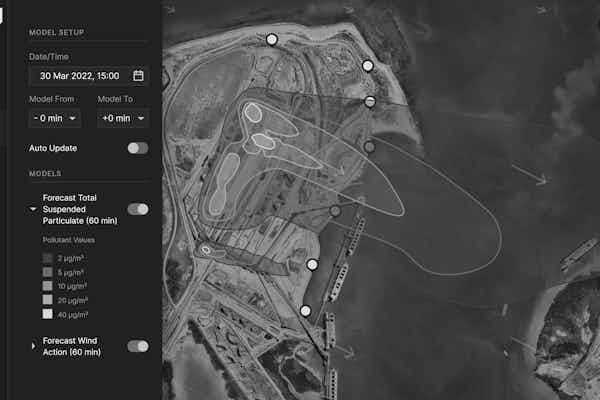
Plan
Air quality monitoring software for industrial operators to stay ahead of emissions impact with predictive insights from air quality dispersion modelling and hyperlocal weather forecasting.
Planning for weather and emissions risk
Most air quality modelling software doesn’t prepare your team for environmental risk
It’s difficult for operational teams to plan for emissions events and high weather risk when presented with too many options. Failure to respond rapidly to unplanned changes in the weather and potential emission events can quickly lead to negative and costly consequences.
EVS Omnis has been built to keep your team aware of what’s next. Actionable insights let you improve efficiencies, reduce the impact of unplanned emissions events and plan ahead with confidence.

Product features
Plan with confidence using hyperlocal weather forecasting and air emissions modelling
When it comes to managing environmental risk and community impact, scheduling operations such as maintenance activities, unloading cargo or blasting based on changes in the weather has a direct impact on your bottom line.
EVS Omnis provides more predictive insights than any other air quality modelling software so your team can manage risk by acting on air quality impact events before they happen.
Model air quality impact, dust and odour emission events
Adjust your operations with certainty based on environmental events that you know are problematic.
Site-specific air emissions modelling and hyperlocal weather forecasts
Run air quality dispersion modelling and calculated ground level concentrations at any location.
Adapt to work shifts with high weather and air quality risk
Keep operations at full speed when you know there is a low risk of breaching compliance or impacting the community.
Schedule activities based on air emissions modelling and weather forecasts
Lower capital expenditure on mitigation resources, optimise your site’s performance and maximise productivity.
Inside the product
Operational guidance supported by weather forecasting and air quality dispersion modelling
Your team will know how to approach the next 72 hours using air quality dispersion modelling to plan for dust or odour emissions, and prepare for times of high weather risk.

Unlock value of your assets and lower capital expenditure
Apply mitigation control at the right time from weather forecasting and optimising your operational activities based on air quality dispersion modelling.

See the future with hyperlocal weather forecasting
Reduce the impact of unplanned emissions events and plan ahead with confidence knowing how your site will be affected by weather events.

Reduce stoppages and avoid weather-related workplace incidents
Eliminate risk of harmful emissions leaving your fenceline that lead to incidents in community, severe regulatory fines and stoppages at your operation.
RECOMMENDED PRODUCTS
Other EVS Omnis modules you may be interested in

Customer service
World class service to help your site get up and running quickly
Our team of specialists will work with you to address your site's specific requirement. We can answer questions you may have about operational or environmental challenges you may be experiencing at your site.
We can make recommendations for third-party hardware our we can hook directly into pre-existing environmental monitoring and sensor networks at your site.
FAQs
Here are answers to common questions about Operational Control. Reach out to our team today if you don't see the answer you are looking for.
Envirosuite can model emissions from the operations using local continuous meteorological monitoring data (near real time air dispersion modelling) or using high resolution weather forecast data (forecast modelling for impact assessment and risk evaluation). The forecast model will provide an assessment of potential impacts extending from the current time out to 72 hours into the future at 1-hour timesteps. Advanced notice of potentially high- risk conditions enables the operation to make necessary adjustments before an adverse dust impact begins to occur and avoid risk. Discrete receptor locations can also be set in the system.
Real time modelling is used to assess the relative contribution of different emission sources to the total predicted concentration at any discrete receptor. This is another method of identifying the likely key contributing sources to potential impacts at a specific location, enabling control measures to target the source and ensure a problem does not occur.
Catch up on the latest insights from EVS Omnis
about your air emissions modelling requirements.